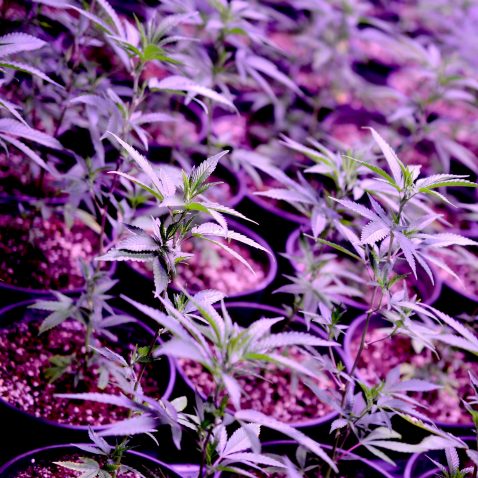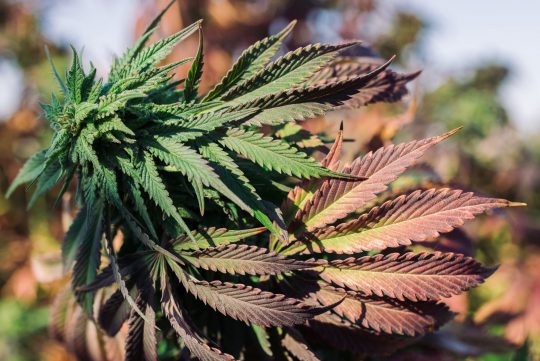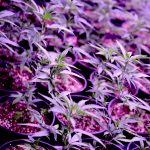Photoperiodism and the Infamous 12/12
During the summer, outdoor cannabis crops flourish under the intense rays of the sun. Summer months have the longest daylight hours of the four seasons, which is why cannabis plants do their growing during this time.

However, as the summer months wane, the sun’s light no longer lingers for a long time. As fall descends, deciduous trees mark the change in temperature and daylight. It’s at this transitional point that cannabis plants respond to a lack of light by flowering.
When cannabis plants flower, they are responding to the impending cold temperatures on the horizon. They also know that their time on this planet is nearing an end, and it’s essential that they produce the next generation of marijuana seeds.
This is why cannabis growers came up with the infamous 12/12 light schedule. 12/12 signifies 12-hours of daylight and 12-hours of darkness.
It’s been found that cannabis plants that are kept under 18-24-hours of continuous light will remain in the vegetative state for an untold amount of years.
What is Photoperiodism?
Photoperiodism is the ability of organisms, including plants, to sense changes in the length of the light and dark periods of a day and use this information to trigger specific physiological and behavioural responses.
It is a biological mechanism that allows living organisms to adapt to changing environmental conditions, particularly those associated with seasonal changes.
Photoperiodism plays a crucial role in regulating various processes in plants, including flowering, budding, dormancy, and the production of bulbs and tubers. Plants use photoperiodism to coordinate their growth and reproduction with factors such as temperature, humidity, and nutrient availability.
In plants, photoperiodism is mediated by specific genes that are sensitive to changes in light and dark conditions. These genes encode proteins that are responsible for sensing changes in photoperiod, and their expression is regulated by photoreceptor proteins that respond to specific wavelengths of light.
The photoreceptors are found in the cells of the plant’s leaves, which receive the information about the changes in light and dark periods, and the physiological responses occur in various parts of the plant.
Cannabis and Photoperiodism
The cannabis plant is a short-day plant, which means that it requires prolonged periods of darkness to induce or trigger flowering and the production of Phyto cannabinoids.
In contrast, long-day plants require a minimum number of hours of daylight to flower; otherwise, they remain in the vegetative stage. The photoperiod of cannabis plants is a critical factor in optimizing yields and quality, particularly for medicinal and recreational use.
Proper regulation of photoperiod ensures that the plants remain in the vegetative stage until the optimal time for flowering, ensuring the production of a high-quality product.
Cultivators manipulate the photoperiod of cannabis by controlling the light cycle of plants in indoor grow rooms, greenhouses, or outdoor locations. The most common technique is to provide plants with a minimum number of hours of uninterrupted darkness, usually 12 hours.
This induces flowering and the production of Phyto cannabinoids. Cultivators can also manipulate photoperiod by providing additional light or darkness to the plants to accelerate or slow down their growth and development.
Several studies have investigated the optimal photoperiods for growing cannabis, and according to most of these studies, most cannabis strains respond best to a 12-hour light cycle followed by a 12-hour darkness cycle.
This photoperiod provides the right conditions for plants to remain in the vegetative stage for several weeks before transitioning to the flowering stage. In some cases, cultivators may use longer light periods to delay flowering to achieve other growth objectives.
Factors that Affect Photoperiod in Cannabis
Several factors can affect photoperiod in cannabis, including genetics, age, temperature, humidity, and light intensity. Plant genetics play a crucial role in photoperiodism, with different strains having varying responses to different photoperiods. In addition, the age of the plant also affects photoperiod, with younger plants requiring shorter photoperiods to trigger flowering.
Temperature and humidity also affect photoperiodism in cannabis, with high temperatures causing stress and reducing the plant’s ability to respond to photoperiod. High humidity levels can also lead to mold and fungal growth that affect plant growth and development. Light intensity also plays a role in photoperiodism, with high-intensity light increasing the speed of photoperiodic responses in plants.
Summary
Photoperiodism is a fundamental aspect of plant biology that plays a crucial role in regulating various processes in plants, including flowering, budding, dormancy, and the production of bulbs and tubers.
Cannabis is a short-day plant and requires prolonged periods of darkness to induce flowering and the production of Phyto cannabinoids. Proper regulation of photoperiod ensures that plants remain in the vegetative stage until the optimal time for flowering, ensuring the production of the highest quality product.
Understanding the relationship between photoperiodism and cannabis is essential for cultivators to optimize yield and quality, particularly for medicinal and recreational use.
Share the Love
If you found this post useful, please let others know about it by sharing it.

